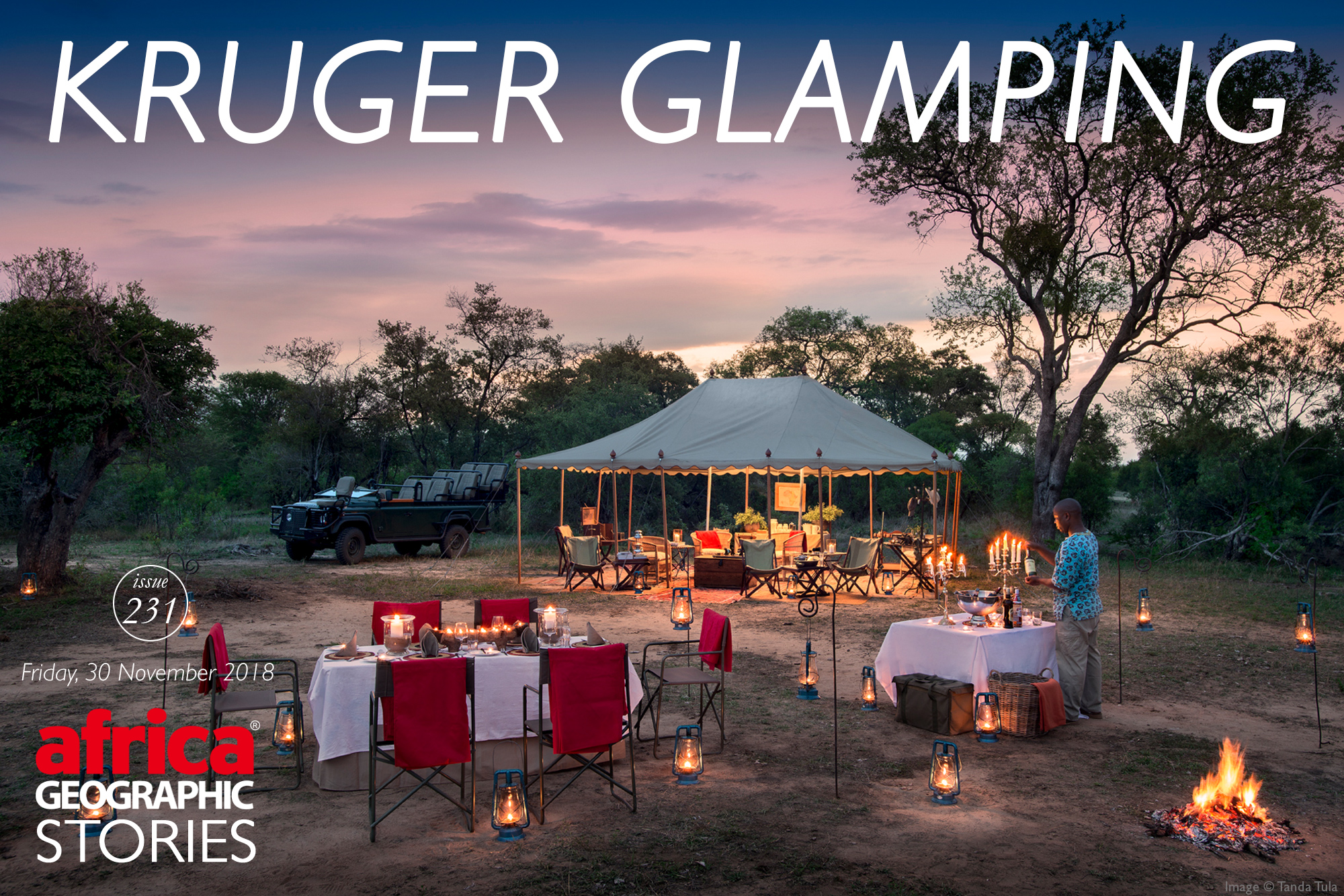
Authentic glamping in the Greater Kruger

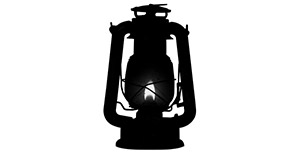
Glamorous camping (glamping) should be an authentic way of enjoying what safari used to be all about. But not too authentic, right? I mean you don’t want to have to catch your dinner or dig a pit latrine. Sure, do away with the permanent lodge structures, but I still want to feel safe and comfortable. Comfy bed, crisp linen, great food, ice-cold drinks and my favourite single malt – tick.
 Find out about Greater Kruger for your next African safari. We have ready-made safaris to choose from, or ask us to build one just for you.
Find out about Greater Kruger for your next African safari. We have ready-made safaris to choose from, or ask us to build one just for you.
Recently my wife Lizz and I had the pleasure of hosting some special people for five days at the Tanda Tula Field Camp in the Timbavati – part of the Greater Kruger, which shares unfenced borders with the national park. Our small group consisted of the 2018 winner and two runners-up of our annual Photographer of the Year competition, and their partners.
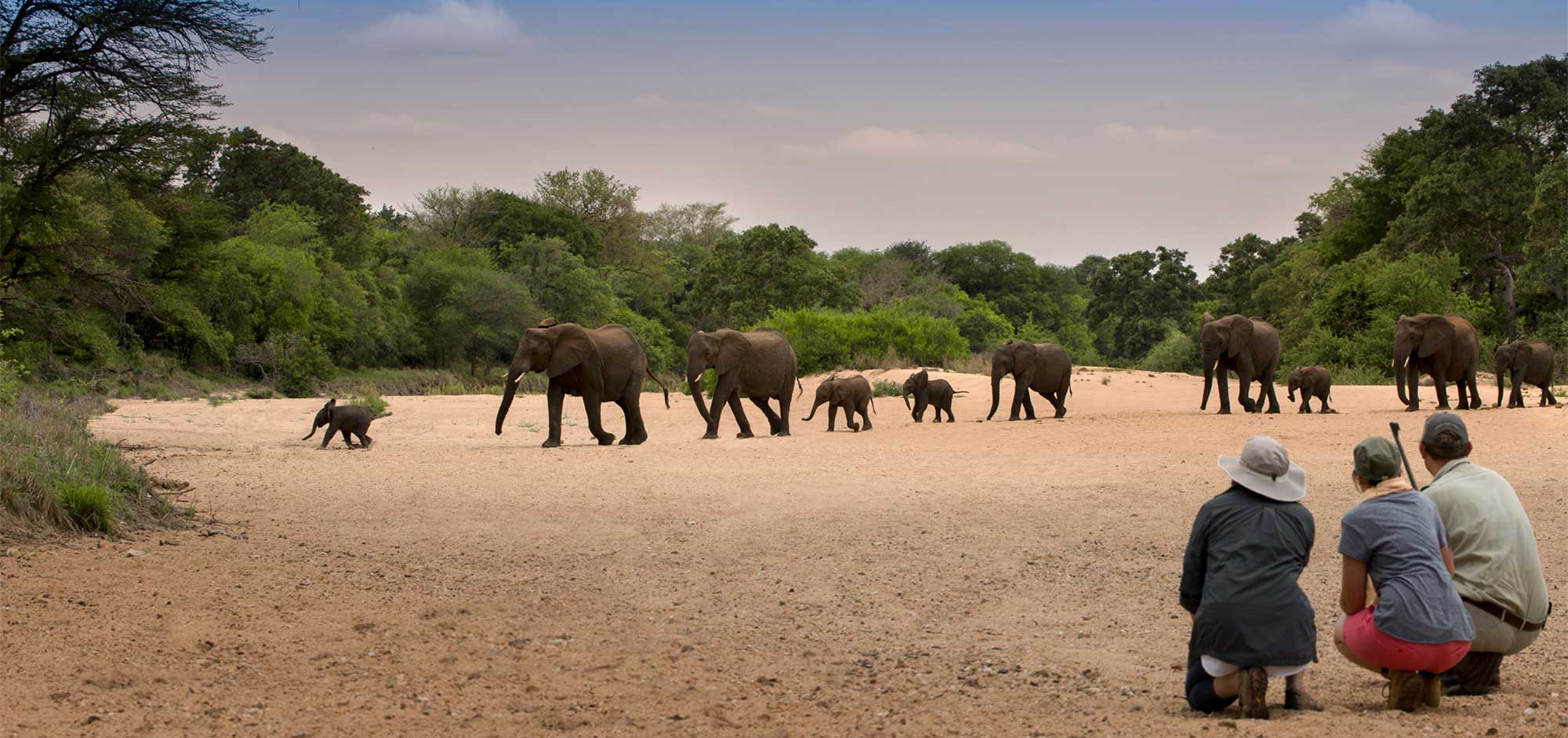
One morning was to be an exceptional experience for all of us. We set out on foot, in the general direction of the Kruger National Park. It was a chilly morning, and the rising winter sun was in our faces as we strolled along, frequently stopping to test the breeze, listen, watch and interpret the messages that were all around us. Reading the bush newspaper, you could say.
A large breeding herd of elephants appeared behind us; as if by magic, as they do. They were moving fast – and we were in their direct path. Tails up and ears flared, trumpeting, tiny babies scrambling to keep up with the herd – something had spooked them. We ducked behind a small copse of gwarrie, there being nothing more substantial in the area, to watch and assess. No need yet to make our presence known and hopefully steer the herd in another direction.
Thankfully, a few hundred metres from us, the matriarch veered off in a northerly direction, and they all followed suit. Still stressed, moving fast. There were a few large bulls in hot pursuit of the herd; perhaps musth bulls looking for mating opportunities? One bull leered at us as he swaggered past. Perhaps the bulls had caused the angst, or maybe the lions that we heard during the early morning hours were working the herd. This is what bushwalking is all about, and with excellent guides, the danger of the moment is turned into a practical lesson.

Essential for this kind of experience is your guide and tracker team. Anthony Collett and Ginger Ubisi were like blood brothers, knew the area like the back of their hands and seemed to read the bush news as easily as I read my mobile phone feed. Many of our encounters started as bird alarm calls or by following fresh spoor.
But back to the highlight of the morning…
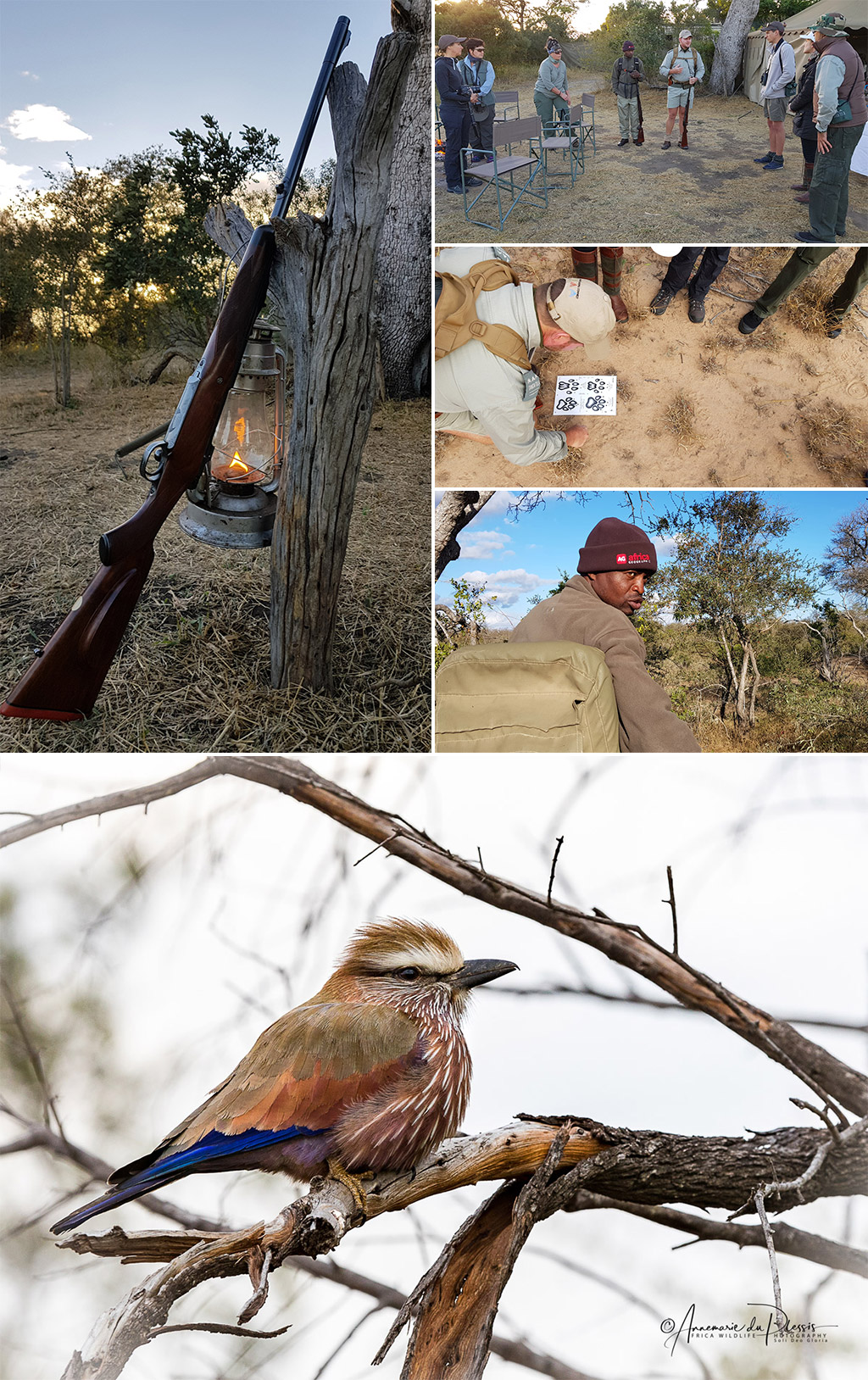
An hour or so later, during an impromptu practical spoor identification lesson, and to our amazement, the shrubs in front of us erupted and reformed into several well-camouflaged men and a dog. Said party seemed not to notice us as they moved swiftly and silently away, clearly following a scent trail – the dog, a Belgian malinois cross bitch, straining at the leash. Like leopards, they melted into the thicket. Their leader came over and briefed us before also vaporising. The message was that this anti-poaching unit was hot on the trail of suspected poachers and that we were to stay in contact.
Timbavati has its own (very effective) anti-poaching operation, which cooperates with those from neighbouring Kruger and other private reserves. We bunkered down, a bit confused (huh, poachers in paradise?) and more than a bit anxious (is this a dangerous situation for us?). Later we heard the sharp crack of three gunshots (R1 automatic rifles, we were later told), followed by shouting and crazed barking from a dog. We all hit the deck, dignity forgotten.
Silence, except for thumping hearts and the commotion some distance away.
Anthony got on the horn, and instead of leading us away from the action, he led us directly to the scene of engagement.
“A bit odd,” mumbled Stuart, exchanging raised eyebrows with his wife Sarah.
But keen to show us South Africans that Aussies are just as tough, they gamely ploughed on. We then came across the scene of two cable-tied alleged poachers being questioned by the anti-poaching team about their presence in the reserve; their guns and other poaching paraphernalia stacked nearby. The dog was hysterical; barking and trying to free herself of harness and handler. With wide eyes, we absorbed as much of the surreal scene as we could, before Anthony called it a day and we headed back to camp.

Back in our safety zone, we gathered around the campfire and discussed the events of the morning. The general vibe was of how efficient and well-trained the anti-poaching team is, and how shocked we all were that evil people could infiltrate and violate Kruger. Of course, we all know about poaching, and we have all weighed in during social media discussions on the topic (like the experts that we are. Not), but to have poachers interfere with our safari is another thing entirely. This means war!
Before long a bakkie arrived in camp – our anti-poaching heroes (avec dog) dropped by for a chat, along with two others we recognised as the alleged poachers. First in camp to greet us was the vicious dog, now all smiling eyes and wagging tail. The morning’s encounter was a training exercise. 🙂
Remarkably realistic, to be sure. I was in on the act – only our guests were not aware that this was a setup. Back in camp, it was terrific to chat over a cup of coffee with the anti-poaching guys – to get a feel for their working day. Such dedicated, remarkable people they are. All brave smiles and evident passion. The team leader was called away early, to attend to an actual encounter on the go some distance away.
Reality check. The message we all took home was how we all vent, judge and express opinions on social media, without really understanding what goes on at ground level. Without truly appreciating that the real heroes are these anti-poaching teams, who live most of their lives away from families and friends, deep in the bush, keeping our wild areas safe from criminals that are intent on turning Africa’s wildlife into trinkets, fake medicine and status symbols. So quick are some to cast doubts on the passion and commitment of these heroes, and to accuse all and sundry of collaboration with poachers.
Another take-out message from the morning was that our contribution, as tourists, goes to funding this essential anti-poaching operation. We do make a real difference by being occasional visitors to protected areas like this. Yes, we do.
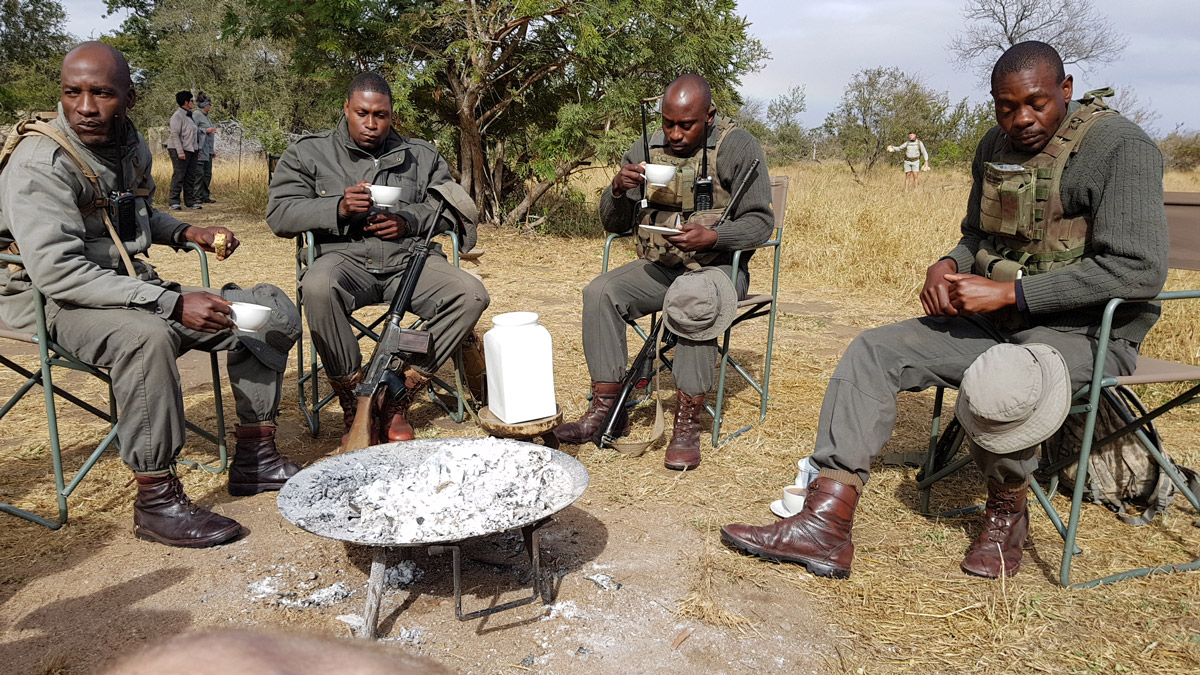
Our encounter with the anti-poaching team was placed into perspective late that same day when we encountered a massive rhino bull. We parked about 100 metres away, and he wandered over and stood for minutes in front of us – a few metres from the vehicle.
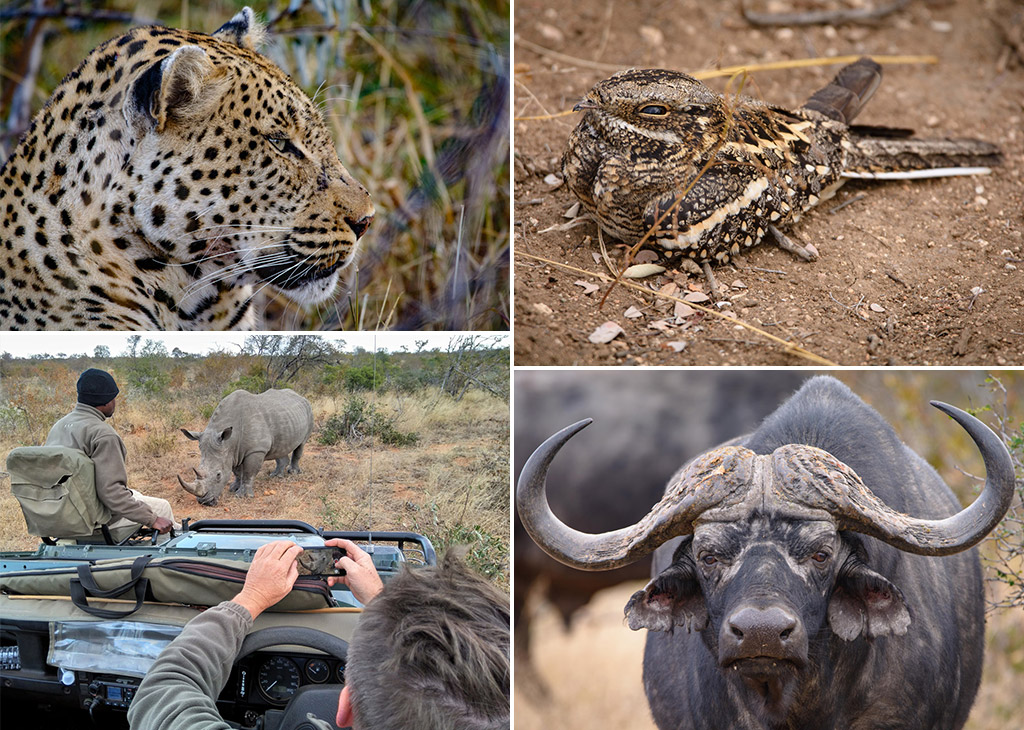
It was a bizarre moment. He seemed to be dozing off in our company, with Ginger in the tracking seat and closer to the rhino than I can spit a dry kudu dropping. It did occur to me how easy it must be for poachers to kill these special prehistoric creatures.
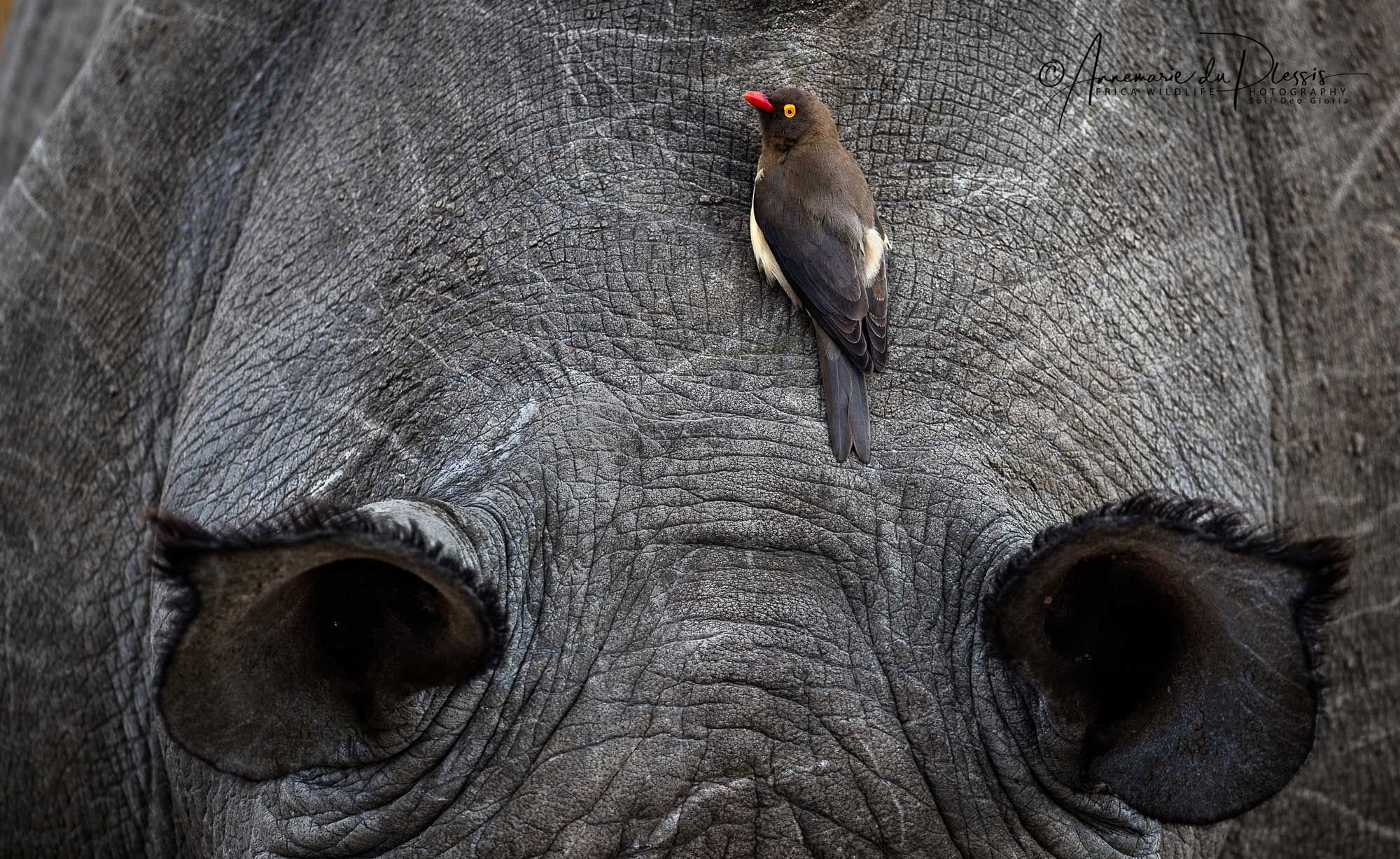
One morning we bumped into the largest tusker I have seen in the Kruger area – a gentle giant by the human name of Apollo. He was in musth, but showing no signs of aggression, or even mild agitation. We parked off about 300 metres away, and Apollo ambled over in that elephant way, time being of no concern.
There is no doubt in my mind that he sought out our company; massive ears flapping lazily as he went about browsing just metres away, chilling and socialising, curious eyes on us but also spaced out by the tannins from the shrubs he was gently nibbling on.
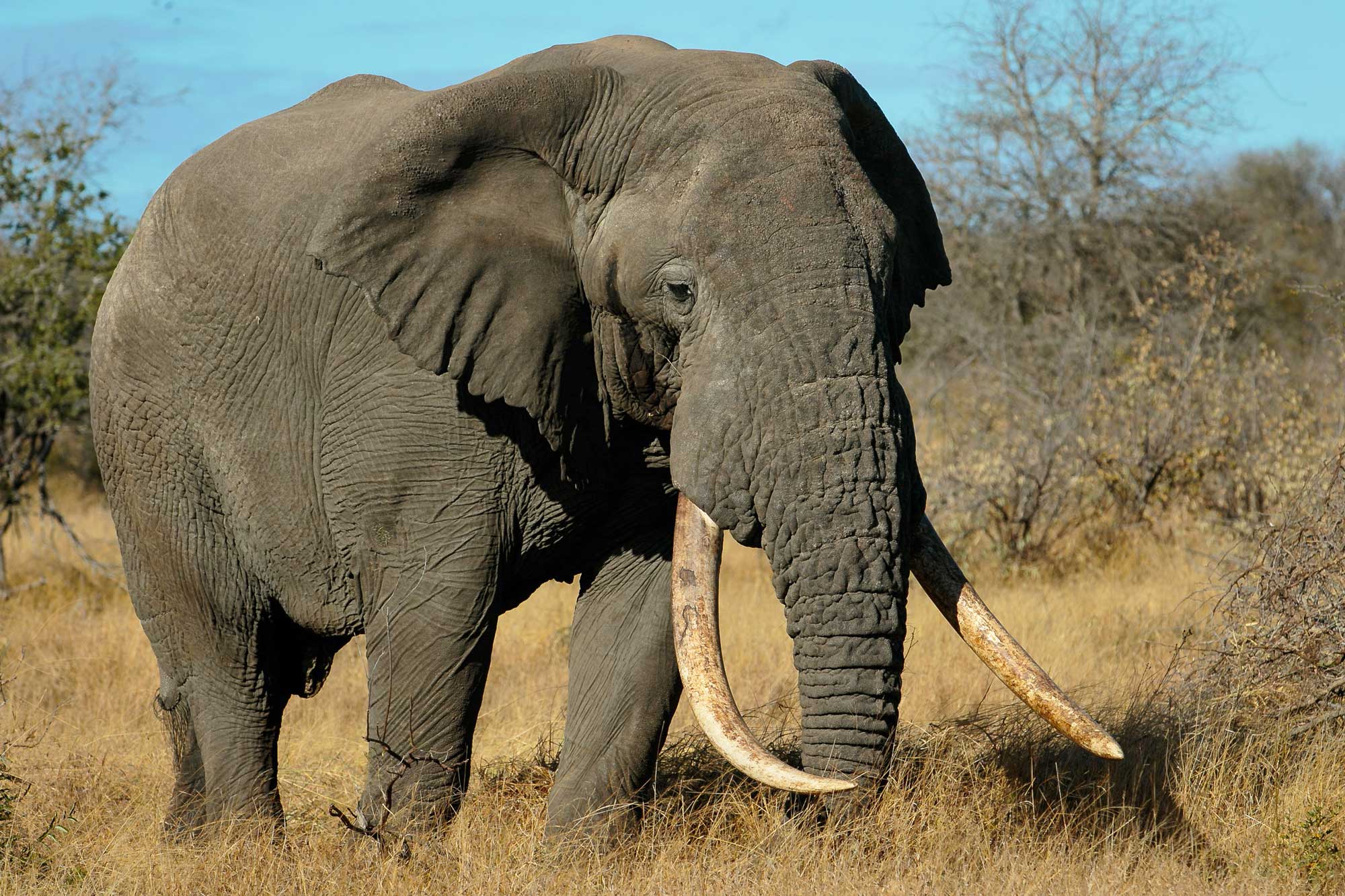
Even Sushil was impressed at Apollo’s sheer size. Sushil hails from Kenya and has spent many hours with Tsavo’s super tuskers, including the legendary Tim.
I noticed Anthony take the necessary precautions for a musth bull (vehicle positioned for easy exit, key turned in the ignition), but on this occasion, this was merely insurance. We hung out together for over an hour, before our departure in search of more bliss.
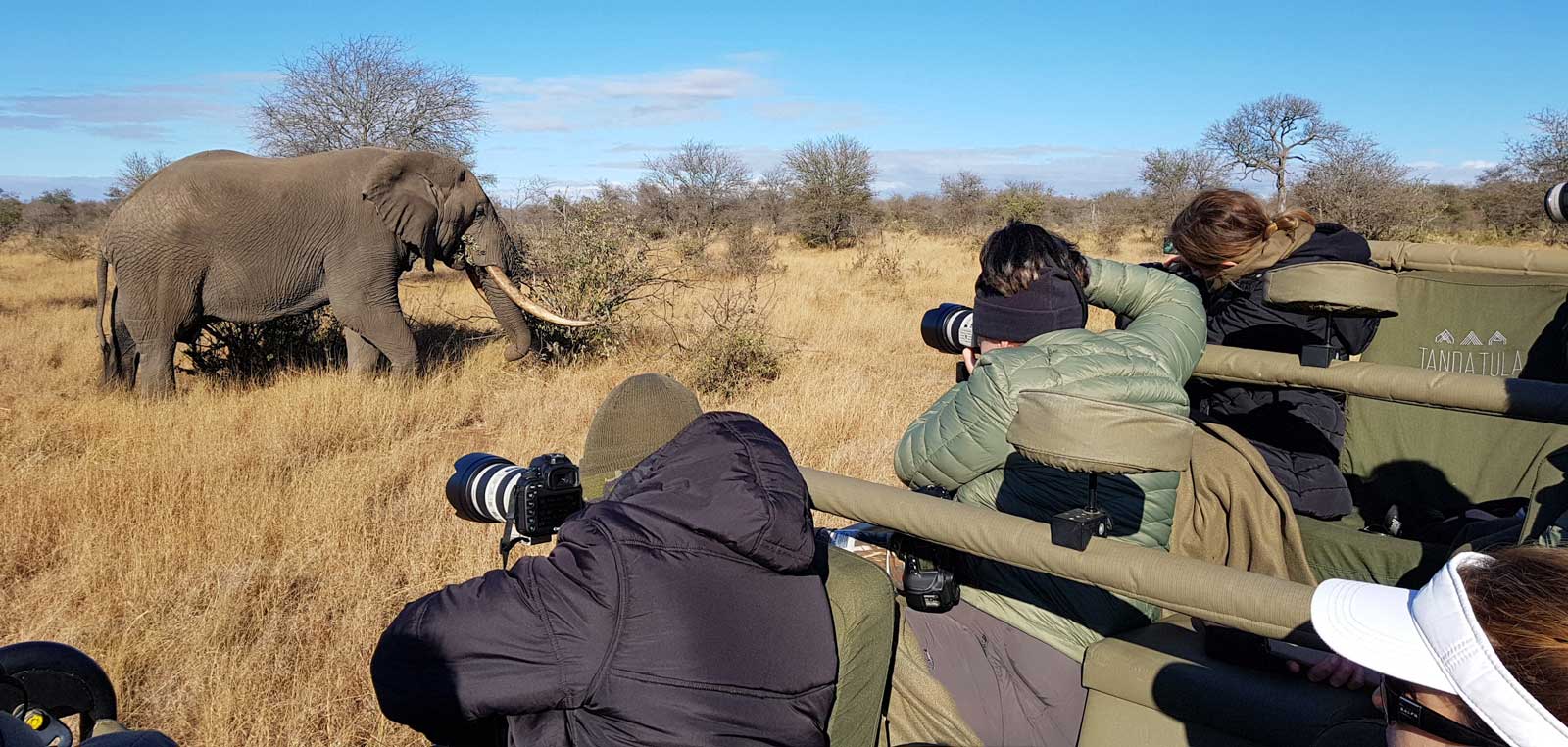
On another morning, and after some astute tracking and reading of the signs, Ginger and Anthony found a mother leopard with her two adolescent cubs. She had stashed a freshly-killed impala in a knobthorn, and the three of them were taking turns up the tree.
The young male scampered when we arrived and ignored mom’s reassuring calls for his return. The young female though seemed to enjoy our presence, fluttering eyelids and all, although she frequently sashayed off to mom for reassurance, the two making a cute leopard pile now and then.
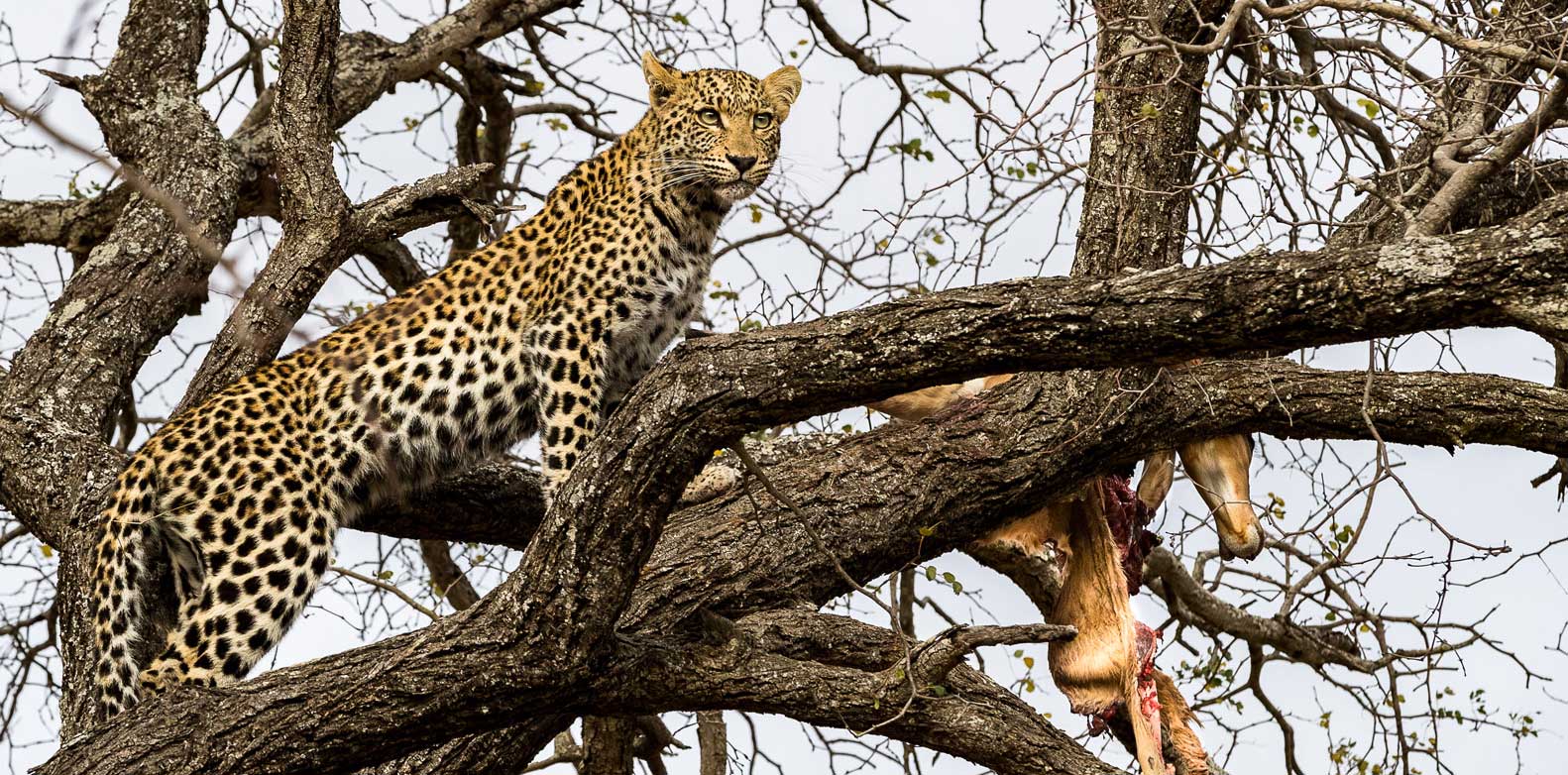
She went up and down the tree several times during our lengthy park-off session. On one occasion, she and mom were on the kill together, and for a few intense seconds, they fought loudly over rights, before mom relented and jumped down to leave her daughter to eat in peace.
I suspect that this was mom’s lesson about fighting for what is yours. We spent a few thoroughly enjoyable hours with the leopards, made even more interesting by watching Annemarie and Zani work the scene.
Annemarie is a technical genius on her camera, always keen to try out creative ways of portraying leopards (her favourite subjects). Her partner Zani provides that vital backup support during intense filming sequences, accompanied by chirping and backchat that kept us all amused.

Later that day, we bumped into the cubs’ father on a warthog kill some distance away; a big Tomcat who rules the area with an iron fist.
Lizz had remained in camp that morning while we were lingering with the leopards, to chill and read her book. She was joined by a pack of wild dogs that loped through camp, mere metres away, casually checking out this temporary setup. Lucky Lizz.
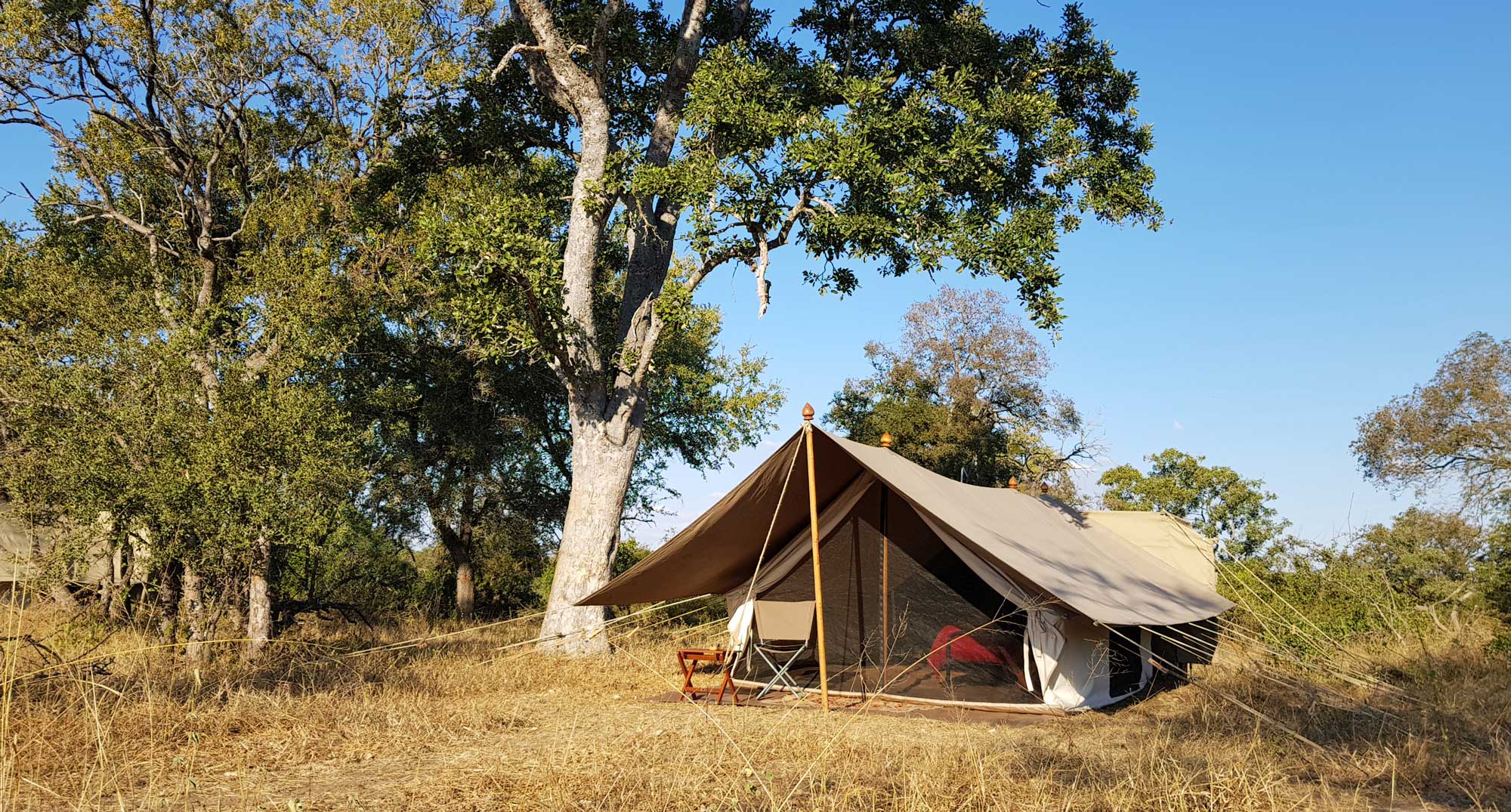
The focus of the Field Camp is to provide that explorer feeling – a shift away from the permanence of a classic safari lodge. The camp is set up anew for each party of guests and taken down when they leave and manned by a full complement of staff to provide for your every need. Somehow this dedicated team churns out mouth-watering meals from a small kitchen area behind camp.
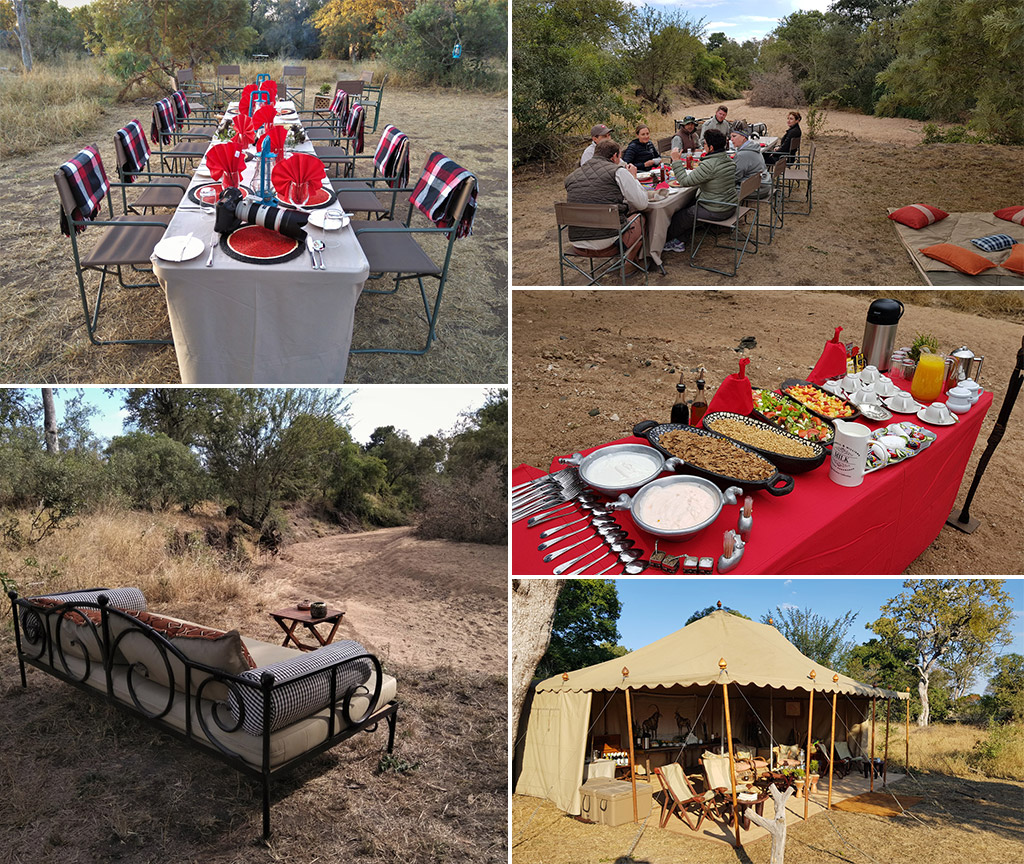
There is a strong sense of family amongst this team, a happy family at that. Every meal was in a different location – in the general camp area, or in the sandy riverbed that runs behind camp. Each tent is discretely positioned under trees, and each has an en-suite bathroom area, with a safari shower (canvas bucket with a tap) which is filled on request with warm water heated over coals. The en-suite toilets are ‘long-drops’, which are composted after every safari. Nothing is left behind once camp is broken, except for footprints.
Most of the moments described above were exclusive to our party – no other vehicles present. Sometimes one, or at the most, two other vehicles would drop by for a short while, and we would all grin at each other. Strangers sharing a special moment. That exclusivity defines this part of the Greater Kruger. Long may it last.

About Tanda Tula
In 1976, Tanda Tula Safari Camp became the first East African-styled, luxury tented safari camp in South Africa. Today, Tanda Tula consists of two exclusive tented camps, located in the heart of the Timbavati Private Nature Reserve in the Greater Kruger National Park: Tanda Tula Field Camp and Tanda Tula Safari Camp. Both camps are owned and managed by Don and Nina Scott, together with their passionate and dedicated team.
TANDA TULA FIELD CAMP
Tanda Tula Field Camp is an intimate semi-permanent bush camp, set up exclusively for each group of guests and taken down when they leave, and manned by a full complement of staff to provide for their every need. The focus at the Field Camp is to give that explorer feeling – a shift away from the permanence of a classic safari lodge. The camp includes a canvas communal area consisting of a comfortable lounge with a variety of chairs and couches, a small library and a self-service bar. This tented area leads to an outdoor fire area for kicking back and sharing your adventures of the day with your favourite beverage in hand.

TANDA TULA SAFARI CAMP
Tanda Tula Safari Camp is situated on the banks of the Nhlaralumi riverbed, deep inside the park. The camp consists of 12 secluded tented suites each with their own private viewing deck high above the often dry riverbed, with views across the Kruger. The camp offers a wide range of safari activities that cater for all type of guests. The camp runs both morning and evening game drives conducted in large open-air 4×4 vehicles with each vehicle holding up to six guests. The camp also provides an animal tracking experience, guided walking safaris, stargazing, birdwatching and bush picnics.
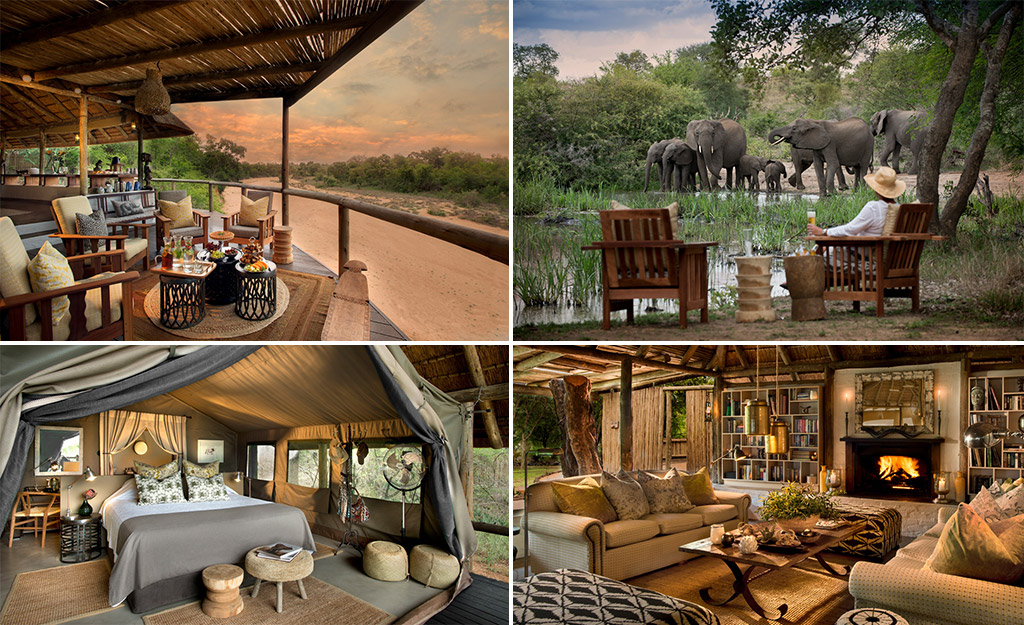
ABOUT THE AUTHOR, Simon Espley
 Simon Espley is an African of the digital tribe, a chartered accountant and CEO of Africa Geographic. His travels in Africa are in search of wilderness, real people with interesting stories and elusive birds. He lives in Hoedspruit with his wife Lizz and two Jack Russells, and when not travelling or working, he will be on his mountain bike somewhere out there. His motto is ‘Live for now, have fun, be good, tread lightly and respect others. And embrace change.’
Simon Espley is an African of the digital tribe, a chartered accountant and CEO of Africa Geographic. His travels in Africa are in search of wilderness, real people with interesting stories and elusive birds. He lives in Hoedspruit with his wife Lizz and two Jack Russells, and when not travelling or working, he will be on his mountain bike somewhere out there. His motto is ‘Live for now, have fun, be good, tread lightly and respect others. And embrace change.’
To comment on this story: Login (or sign up) to our app here - it's a troll-free safe place 🙂.![]()






